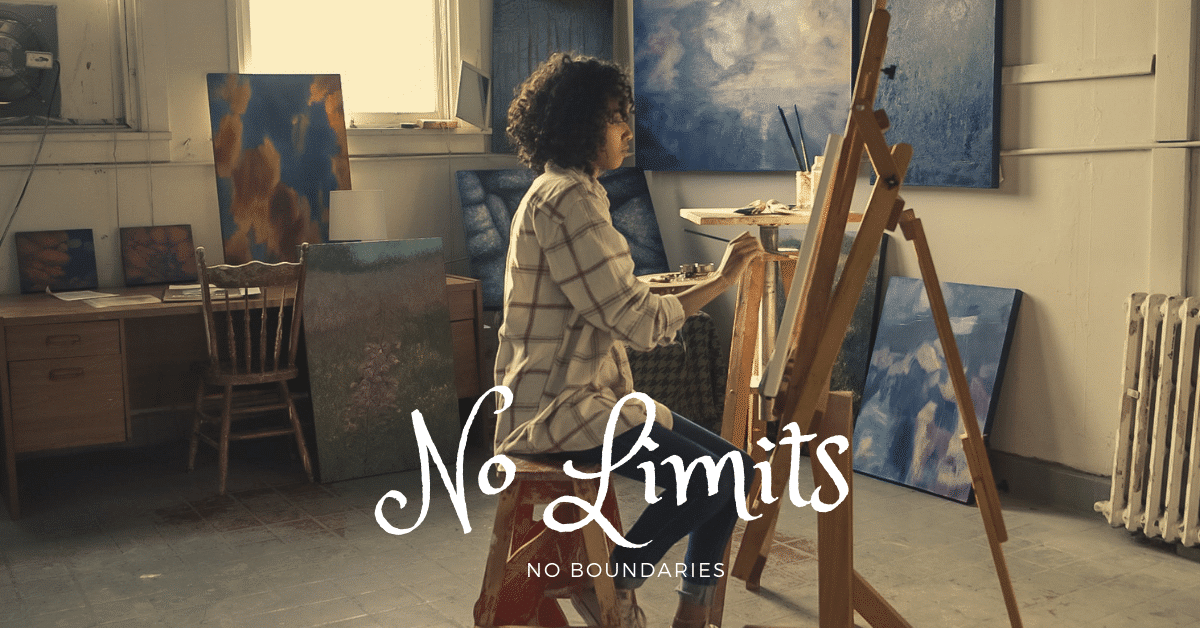There are two types of fisherman – cast-and-hope, cast-and-work. The former put a bait and bobber on the line, throw it out there, pull their hats down over their eyes, and take a nap or maybe curl up with a novel and a bag of pretzels. If something occasionally swims by and likes the look of the worm and bites, they’re happy. Dinner tonight. If, as often happens, they just have a nice day on the lake and end up eating hot dogs that night, they’re OK with that too.
Why Tell a Story: Isn’t Making the Art Enough?
There’s a reason the bait-and-bobber approach is not that of professional fisherman. Those who want to make a living at it are cast-and-work fishermen. There’s no bobber. They put on a lure, designed to broadcast a story to the pond–about a fleeing or injured little fish–that gets the bigger fish interested. Then they work that lure through the water, constantly casting, tantalizing, and reeling in.
Professional artists who sell as though they’re fishing with a bobber, a good book, and a sack lunch are going to have some opportunistic sales–if they go long enough. But the guys winning the big awards for hauling in whales don’t think the worm is enough. They’re casting a narrative around it. They’re telling a story.
As a corporate storyteller and brand narrativist, I help companies and professionals find and tell their story. Not their history or philosophy–a story is not a resume, bio, or standard artist statement. Rather it’s their brand story or, if you prefer, their art story. The art story isn’t the entire artist statement or profile, but it forms a part of it–a central part. It’s the crux–the reason we care.
When I see artist profiles that have no stakes to raise and no story arc–no problem and no solution–I feel the same way I do when I read a company’s “About” page, and it’s just a lot of company history and nebulous principles. I feel disengaged. It doesn’t make me want to look further–at the services list or the artist portfolio.
Why the Story Format: Can’t We Just Explain Our Ideas?
Artist profiles are rife with concept language: “I believe in the energies between and interconnectedness of all things…” They’re most often statements of philosophy–bad, amateur philosophy, but still. And yet theoretical concepts that never touch the ground rhetorically have never inspired the bulk of people. Someone is reading the most obscure paragraph of Hegel and plotting the overthrow of society, but most of us are over here, gathered around the campfire, swapping yarns.
Of course, we run into a certain skeptical tendency of modern anti-intellectualism. It says there are no rules and puts everything in quotes. What isn’t a “story” to me might be a story to someone else and vice versa–so the rhetoric goes. Everything is a story, it says, and stories are life, and life is everything, so everything is everything, so why do anything? Everything is just fine the way it is. And sure, we can check out, turn our minds off, and equate all things with all things. But then you wouldn’t be reading this, and I darned sure wouldn’t bother to write it; I wouldn’t have gotten out of bed this morning–or any morning. I’d be withering while the cat gnaws off another of my toes for breakfast.
See? That cat eating the toes part got you. That’s because regardless of what lofts our brains propose to inhabit, our minds and emotions live down here, where actual things happen, with actual characters active in the narrative. That’s what separates a story from a pseudo-philosophical blurb. There are actually rules to making a story.
What’s the difference between “good overcomes evil” and “Jim wouldn’t let the killers get away with it; he was determined to bring them to justice”? What’s the difference between “harmony in the cosmos is important” and “The rebels fought against the empire’s might and control because, without fighting, there would be nothing to go home to.” In both cases, it’s the presence of characters who are active–pursuing a goal–solving a problem. Those are a story’s ingredients. When an artist profile gives us that, it’s got a story.
What Characters: Doesn’t the Artist Stand Alone?
First, let’s clarify what we mean by an artist story. It’s not an “artist’s” story, as in a bio–”I grew up in Laramie, Nebraska, population 400, had a Chihuahua and a pet fish named Bernie…” An art story is a method of communicating why an art practice matters. That art story has a cast of relevant characters.
The essential characters are threefold: the artist, the art, and the world (in one form or another). Those three are really non-negotiable. And they bring up a couple of points and a couple of myths to debunk. It’s doubtful we disagree about the artist being relevant, so lets’ move to the other two characters:
Character: The Art Itself
The art is a character and, like all characters in a story, it must be actively working to solve a problem and achieve a goal. That’s right: art that doesn’t solve a problem isn’t worth hearing about. Unless one just happens to love the piece at first glance and wants to take it home–which happens if you wait long enough and maybe wait some tables in the meantime–the art doesn’t sell itself. See the bait-and-bobber analogy above.
The myth this debunks is Myth #1: If the art is good enough, it’s all you need. That’s nonsense. Art with a story will consistently outsell art with nothing else. Collectors want the story, as do curators, commercial buyers, gallerists, etc. One might even say that buyers who just want the art and not the story are buying decorations, and not art at all. If you don’t care what you’ve got–you just like that it’s “pretty” or “affects” you–then arguably, what you’ve got is pricey wallpaper. I’m not knocking it–I’ve seen some pretty inspiring wallpaper. It’s just the difference between “background music” and music. In the film Unbreakable, when an art dealer (Samuel L. Jackson as Elijah Price) wouldn’t sell a piece to a customer who didn’t understand what he was buying, this was the point he was making.
When I see an artist homepage, and it’s just the art, nothing else–maybe an artist photo and brief bio, but no context–I feel like someone handed me a book with no cover, no title page, and with the pages in random order. I lost interest when THEY shrugged over it. I shrugged, too. Visual art without at least some attempt to communicate context places so much burden on the visuals themselves as to be unrealistic. It’s like if I just randomly walked up to people on the subway and said: “Adam Smith’s labor theory of value is experiencing a renaissance in some South American countries struggling over import/export disparity.” The stranger looks at me. “OK… I’m getting off here. Excuse me…” On the way out, he asks his friend, “What was that?” No context equals bewilderment, awkwardness, and, frankly, fewer sales.
There’s another myth involved–Myth # 2: Art has no utility. It is not of practical use. It solves no problem. Again, that’s nonsense. Art need not be a product of Bauhaus design to perform a function. When Michelangelo, who preferred to be a sculptor, painted the Sistine Chapel, reluctantly in the service of Pope Julius II (“the fearsome pope”), don’t believe for a second that the Last Judgment behind the altar was meant to inspire anything other than abject dread. All of it served a purpose–geopolitical, social, cultural, and of course religious. Great art always has utility. The opposite of that is to claim it’s “pointless”. And while there is a pointless beauty–the beauty of the cosmos–when an artist handles even the smallest atom of it, he imbues it with purpose.
Character: The World
The world is a character. If art doesn’t engage the world, it’s a hobby–the visual version of journaling. It’s not the endeavor of a professional artist if there’s no point for other people.
The worst poem our siblings force us to sit through over a holiday meal is the one that’s so “personal” only they can understand it. By contrast, the truly personal is imbued with universality, precisely because we are indeed all connected. When you tell of a time you experienced a loss, you don’t just say, “I once experienced a loss. The end.” You make it specific–my dog, my closest friend, my child if you can understand, died in my arms…” Sure the other person’s experience of loss is going to be different in the particular circumstances, but the more specific we get, the more they can vicariously experience the shared qualities of a profound, universal reality–like grief. I don’t know what it’s like to lose a brother, but I lost my grandfather…
Art that lands on no one but the artist is failed art. The world is inherently involved, but most especially when we say “professional artist.” You can’t sell if you don’t regard the buyer as a character in the art story, at least to the degree the buyer is representative of the world you are trying to heal, build, defeat, or otherwise change.
So Myth #3 is this: We make art for ourselves, not other people. It’s hogwash. We hear it everywhere, but it’s the lure of sirens toward the rocks of poverty and a pointless despair. We have to get over it. If art solves a problem, it is for the world, or some segment of it, that it solves it. The world–the buyer–the viewer–is the beneficiary character.
So How Do I Get to a Story: What Are the Ingredients?
We see artists get halfway there. “My art shows x” or “My art reveals y.” It’s good but not quite enough. They’ve got a solution in search of a problem. They’re not conveying any stakes, or the stakes aren’t very high.
What happens without your art? What if it doesn’t exist and the world never has it? If the answer is nothing–no great loss–then either we don’t need the art, or you haven’t gone deep enough into your own motivations for making it.
Expedience, as a methodology, will fail. It will not serve anyone to go looking for just some “story” to drop into their promotional materials that will make people want the art. Nailing the art story takes an intensive deep dive into your own reasons for getting out of bed in the morning. And it cannot be funneled into cheap concept-words and theoretical categories like “the energies between and connectedness of all things.” That’s the pitfall you’ll find when you first attempt it. Our ability to communicate around aesthetics is so paltry these days, it feels like there’s no language for it left but to resort to pop philosophy.
I’m always amazed when an artist would rather be a philosopher articulating some obscure pie-in-the-sky esoterica than get down to earth and as rooted in their real-world motivations as they are in their materials. Resist the ethereal. The moment you’re saying “I believe…” stop, reset, and take another run at the question: What problem does my art solve? Why am I making it vs. something else? What do I care about enough in the world that I get up and put this work into it? It will not be an easy quest, in many cases, for self-knowledge, but it is an essential one.
The Problem (The Stakes or Jeopardy)
When you give an answer to the why, interrogate the answer. Ask that answer, “Why?”. And when you answer that why, ask the why again until you can’t ask it anymore, because you’ve gone as deep as there is to go, sloughing off the BS on the way.
When you find the problem you’re taking on, and get really clear on it, raise the stakes. Amp up the jeopardy in those stakes. What happens if that problem goes unsolved? What if we just do nothing? If the answer is, “Well, it’ll be slightly unpleasant” (basically nothing), then you haven’t got it yet. Nice try–keep digging.
The Solution (The Arc or Change)
But, when you do nail it, and when you get the stakes high enough that we care–that all or most of us care–you are then ready to complete the story arc. You’re ready then to introduce how you solve that problem to bring that jeopardy under control. You’ll need to put as much into this second part of the story. It’s problem/solution. How exactly do you resolve those stakes? And how do you do that, exactly? And how do you do that? Keep going until you can’t ask the “how” anymore.
When you nail it–when it’s not a bunch of concepts, but the stakes are real stakes–something is going to get hurt, lost, destroyed, whatever–and you’ve got a real solution, not a theoretical one–then you’ve got the crux of your story.
Lastly: A Word of Encouragement When You Get Stuck
You may run out of gas a few times and conclude, “I don’t have a story.” It’s true some people don’t, but usually they’re the ones who say, “I just want to make art maybe one day a week in the spare time I have left over from my job–if it’s not too much work to try to do it.” I’m not talking to the dilettantes who want to dabble and pretend to be pro artists, but the professionals who want to make a profession of it–those who want to profess their art. If you want to make a living with your art, and you’re doing what is necessary to make that happen, then there’s no way you’re putting in that kind of effort for no reason and with no deep-seated purpose. There’s a story in there, and you can find it.
I’ll keep throwing story info, insights, and information at you so, if you like this topic, keep your eyes open for it–there will be more. Meanwhile, I’ll leave you with this: your story is another brush, another hand in your clay. We’d love it if you’d share your stories with us.








Daniel, my story starts with the compliment, “That’s pretty good,” and continues 20 plus years to where my art is now. That’s how I start my website’s About page, and let the Artist Statement, Bio and CV follow. Thanks for hitting us over the head with the idea!
Thanks for he very inspiring article that actually sparked off a lot of ideas (even if me as a non-native speaker had to translate a lot of the lingo…).
Alongside reading the article for the first time, I wrote down a version 0.9 of my story and am confident that with re-reading the nucleus story and the article text, I’ll sort of make it to a a really good story and also a clear positioning in an attractive market. Now FINALLY I feel that I understood that concept about “importance of your brand” and “tell your story”. The text is really to the point and it helped me a lot towards understanding who I am an how my art is solving problems in the world out there. It’s not just decorative wallpaper I am making and I understood the reason why for the first time today. THANK YOU!